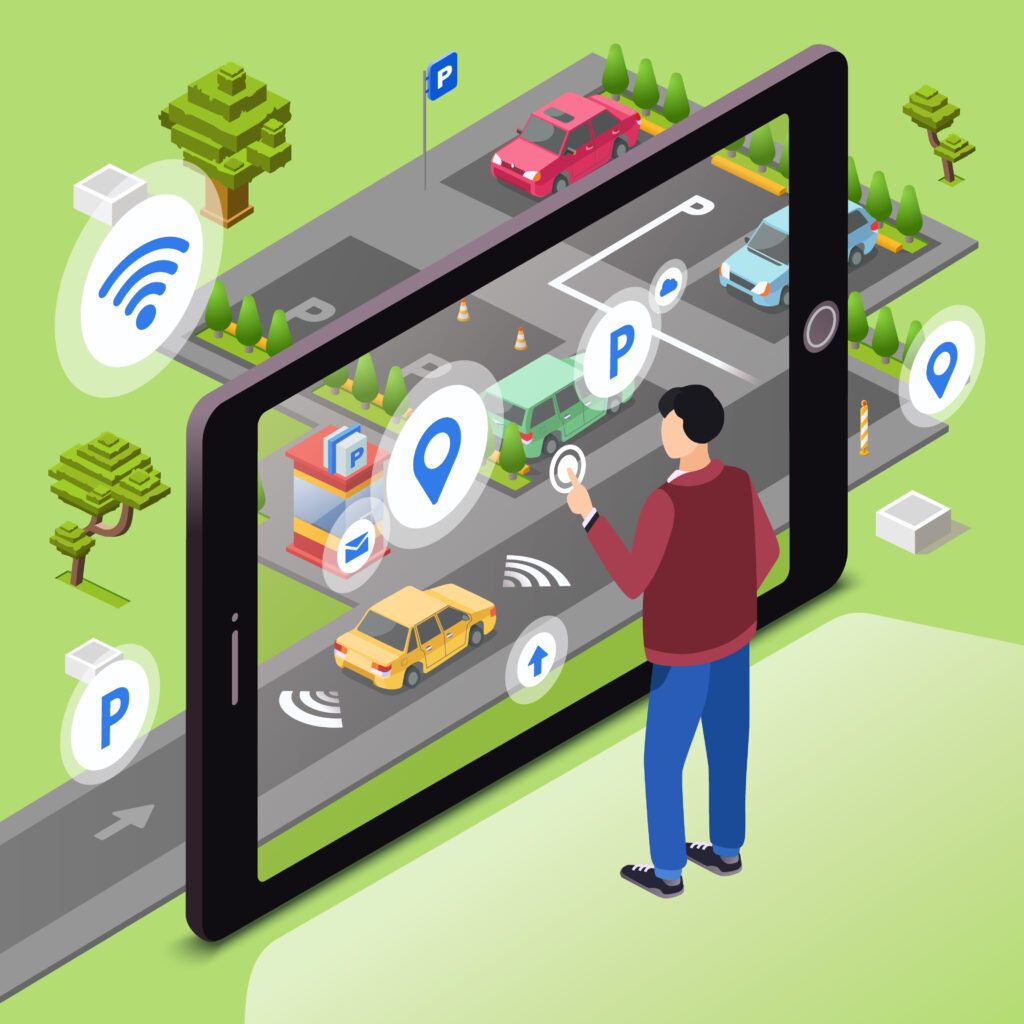
Smart parking vector illustration. Man user with smartphone touch screen control car driving to parking lot through internet connection of smart technology communication. Isometric cartoon flat design
Taxis have always been part of city life. They pick us up late at night, save us from missed trains, and carry tourists with suitcases. But for many years, the taxi experience felt old-fashioned: hailing on the street, waiting, and dealing with cash or clumsy card machines. That changed when cheap smartphones and smarter software arrived. Today, the taxi is as much a screen experience as a street one. In fact, many startups turn to a Taxi App Development Company to speed that shift and build apps that riders and drivers actually love.
This article walks through how technology revived taxis. We’ll look at the real tech that made the change, the business shifts, and the human side that still matters. If you run a taxi firm, work in transport, or just love urban tech, this is for you.
A quick history: taxis before the smartphone
Taxis started as horse-drawn carriages, then moved to motor cabs. For decades, hailing was physical and local. Dispatchers used radio or phone. Payments were often cash. Records were paper. The system worked, but it had limits: poor visibility, inconsistent driver quality, and weak pricing signals.
The first wave: ride-hailing disrupts the streets
When ride-hailing apps arrived, they did two simple things well: match riders and drivers fast, and accept digital payments. That combo sounded small but it changed behavior. Riders stopped waiting on corners. Drivers found passengers more reliably. Streets filled with app-based cars. The taxi industry shifted from being place-based to being platform-based.
Why taxis needed a digital revival
Cities got denser. People wanted convenience. Competition arrived. Ride-hailing showed what customers expected: speed, transparency, and safety. Traditional taxi companies that didn’t move online lost market share. The solution was obvious: digitize the core product. Digitization meant better matching, real-time data, and new revenue paths.
Core technologies that changed taxis
GPS and mapping
Knowing where a car is and how to get to a rider in minutes is the heartbeat of modern taxis. GPS made estimates reliable. Routing algorithms shaved minutes off trips. Maps gave drivers fewer wrong turns and riders clearer ETAs.
Mobile payments
Accepting cards and mobile wallets removed a key friction. Riders no longer needed exact change. Cashless payments increased average ticket sizes and sped up trips. It also made accounting and compliance easier.
Real-time telemetry & cloud services
Cloud servers and real-time telemetry let platforms track thousands of rides at once. Fleet managers can now monitor heatmaps of demand. Predictive models forecast where a surge will happen. That kind of scale was impossible with paper logs.
The app model: convenience, visibility, trust
The app turned taxi service into an on-demand utility. Riders can see driver details, estimated cost, and trip time. They can share the journey with loved ones. Ratings keep drivers accountable. Together, these features build trust. Visibility reduces uncertainty—a huge win for daily commuters.
How drivers benefited from digital tools
Better earnings and routes
Apps guide drivers to the nearest fares, reducing idle time. Drivers accept trips with clearer fare estimates and better routing. Earnings become more predictable.
Safety and performance tracking
Digital logs provide proof of routes and help resolve disputes. Ratings and feedback help drivers improve. Many platforms add safety features like SOS buttons and incident reporting.
How cities and regulators responded
The rise of app-based taxis forced regulators to act. Cities balanced innovation with public interest. Rules evolved for licensing, background checks, fare caps, and data sharing. In many markets, regulators now require platforms to report trip data to help with planning and congestion management.
New business models: subscriptions, corporate rides, multimodal
Apps unlocked new business models. Monthly commuter passes, corporate accounts, and multimodal integration (linking buses, bikes, scooters) became possible. Fleet owners can run subscription services or offer premium ride tiers. These models create steadier revenue and better user retention.
Design matters: UX choices that made apps stick
Small design decisions drove big adoption. Clear onboarding, fast booking flows, and minimalist interfaces reduce friction. Microcopy that explains surge pricing or cancellation fees prevents user frustration. Push notifications that respect timing — not spam — pull in users without annoying them.
Operational backbone: dispatch, dynamic pricing, and analytics
Under the hood, platforms run complex systems: dispatch algorithms, dynamic pricing engines, and analytics dashboards. Dispatch optimizes for wait time and utilization. Surge pricing balances supply and demand. Analytics spots trends: which neighborhoods need more cars, or when promotions work.
Safety and trust features that rebuilt confidence
Apps introduced safety layers: driver verification, vehicle inspection records, ride tracking, SOS functions, and in-app chat. These tools gave riders confidence and created better standards across the industry. Insurance and compliance integrations further stabilised the market.
Sustainability: electric fleets, ride-pooling, and emissions tracking
Technology also enabled greener options. Apps can offer electric vehicle (EV) filters, encourage pooled rides, and measure emissions saved. Some platforms reward eco-friendly drivers or integrate with city EV charging networks. These features matter to cities and increasingly to riders.
The role of partnerships and APIs
No app is an island. Successful platforms partner widely: payment processors, mapping providers, public transit APIs, and fleet management systems. Open APIs enable integrations, like unlocking a shared bike mid-ride or offering multimodal trip planning. Partnerships scale reach without expensive in-house builds.
What remains human: service, drivers, and local flavor
Even with screens, people still value human service. Drivers offer local knowledge, personal care, and moments of connection. Small gestures—helping with luggage, chatting about the city—create loyalty. The best platforms combine tech with respect for the human element.
Lessons for legacy taxi companies moving online
If you run a traditional taxi firm, the path is clear: digitize booking, adopt cashless payments, train drivers on app etiquette, and use data to optimize dispatch. Start with a pilot city, learn, then scale. Investing in UX and driver support matters more than flashy features.
What’s next: 5G, AVs, and hyperlocal mobility
The future looks layered. 5G will lower latency for smoother maps and real-time safety features. Autonomous vehicles (AVs) will change fleet economics, especially for fixed routes. Hyperlocal mobility—mixing on-demand shuttles, bikes, and cars—will make city travel seamless. Apps will orchestrate these options.
Conclusion
Technology gave taxis a second life by fixing old frictions and adding scale. GPS, payments, cloud services, and smart UX turned a local street service into a global, digital product. But success wasn’t just technical. It required new business models, safety rules, and human-centered design. For legacy operators, moving from streets to screens is both necessary and possible—if done with care, testing, and the right partners. When you’re ready to modernize, consider expert help to build, refine, and scale your digital experience with a trusted mobile app development company in USA.
Frequently Ask Questions
1. How quickly can a traditional taxi fleet launch an app?
Ans: With a focused plan, a minimum viable product can launch in 3–6 months. Start small, validate in one area, then scale.
2. Do apps help drivers earn more?
Ans: Yes—apps reduce idle time and find more fares. Earnings depend on pricing, commission, and demand, but many drivers see improved utilization.
3. Are ride-pooling features profitable?
Ans: Pooling can increase per-vehicle utilization and reduce cost per rider, but it needs good routing algorithms and strong demand density to be profitable.
4. How important is local regulation compliance?
Ans: Very important. Ignoring local rules can halt operations. Engage with local authorities early and use compliant workflows.
5. Will autonomous vehicles replace taxi drivers soon?
Ans: Not immediately. AVs will first serve controlled environments and fixed routes. Human drivers will remain essential for varied urban trips for many years.


